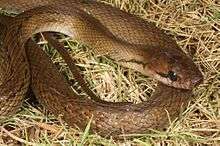Coelognathus
| Coelognathus | |
|---|---|
 | |
| Montane Trinket Snake (Coelognathus helena monticollaris) | |
| Scientific classification | |
| Kingdom: | Animalia |
| Phylum: | Chordata |
| Class: | Reptilia |
| Order: | Squamata |
| Suborder: | Serpentes |
| Family: | Colubridae |
| Subfamily: | Colubrinae |
| Genus: | Coelognathus Fitzinger, 1843 |

Coelognathus is a genus of five ratsnakes that were formerly assigned to the genus Elaphe. Based on morphological evidence and protein similarities, in 2001 Helfenberger re-validated the name Coelognathus that had originally been proposed by Leopold Fitzinger in 1843.[1] The distinction between Coelognathus and Elaphe was further supported by mitochondrial DNA sequence and additional morphological evidence in 2005.[2]
Species
The following species are recognized as being valid:[3]
- Coelognathus enganensis (Vinciguerra, 1892)
- Coelognathus erythrurus (A.M.C. Duméril, Bibron & A.H.A. Duméril, 1854) – Philippine rat snake
- Coelognathus flavolineatus (Schlegel, 1837) – yellow-striped ratsnake
- Coelognathus helena (Daudin, 1803) – trinket snake
- Coelognathus radiata (F. Boie, 1827) – copperhead ratsnake
- Coelognathus subradiatus (Schlegel, 1837) - Indonesian ratsnake
Nota bene: A binomial authority in parentheses indicates that the species was originally described in a genus other than Coelognathus.
References
- ↑ Helfenberger N. (2001). "Phylogenetic relationships of Old World ratsnakes based on visceral organ topography, osteology, and allozyme variation". Russian Journal of Herpetology. 8: 1–62.
- ↑ Utiger U, Schätti B, Helfenberger N (2005). "The Oriental colubrine genus Coelognathus Fitzinger, 1843, and classification of Old and New World racers and ratsnakes (Reptilia, Squamata, Colubridae, Colubrinae)" (PDF). Russian Journal of Herpetology. 12 (1): 32–53.
- ↑ "Coelognathus ". The Reptile Database. www.reptile-database.org.
Further reading
- Fitzinger L. 1843. Systema Reptilium, Fasciculus Primus, Amblyglossae. Vienna: Braumüller & Seidel. 106 pp. + indices. (Coelognathus, new genus, p. 26). (in Latin).
This article is issued from
Wikipedia.
The text is licensed under Creative Commons - Attribution - Sharealike.
Additional terms may apply for the media files.